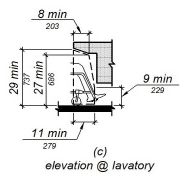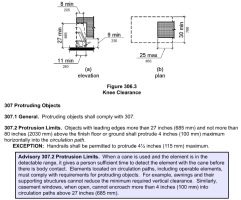See the last paragraph here:
https://www.steppingthruaccessibility.com/the-lavatory/
"One more item to consider. If the underside of the lavatory is more than 27” AFF for the front 8” or more of depth, and if the fixture (or its counter) can be approached from the side of the fixture, you might now have a protruding object that is more than 4” from the wall which would then requires a cane detectable barrier. If the front edge of the lavatory is at 27” AFF exactly, this is a non-issue. But if you are in California, the front 8” (to 10”) tapers from 29” minimum AFF down to 27” AFF. So in California, if you can approach the side of the lavatory you will most likely always have a protruding object and a cane detectable barrier is needed. This can be as simple as providing a side piece to the counter where the leading edge goes down to 27”or less AFF. But keep in mind, this side piece might need to provide 18” minimum clear from the centerline of the lavatory in California if it goes below 27” AFF. So this sums up why knee/toe clearances, reach ranges, and protruding objects for lavatories are important to understand."
Keep in mind that cane detection is specific to the direction of travel. ADAS 307.2 addresses protruding objects "within a circulation path". So, is the lavatory "within a circulation path", or merely one of the end points of a circulation path?
IMO the front of the lav marks the terminus of the circulation path. That is the only way a California lavatory is not considered a protrusion - - see Fig. 11B-306.3(c) below:
View attachment 15566
The question remains, is the side approach to the lav considered as being "within a circulation path"? The code does not state explicitly at what point a side approach is able to occur. I think that most visually-impaired users know that when they are in a restroom, there will be plumbing fixtures along a wall. (The protrusions that surprise them more often are oversized paper towel dispensers.)
One other consideration as to whether a side approach is possible to compare the area to an alcove as per fig. 305.7.2:
View attachment 15571
So if the side edge of the lav is more than 60" away from the edge of the water closet or other obstruction, then maybe there is a protrusion issue requiring a wall, partition or guar
an accessible sink in 34" high counter must be an under mount type sink. If using a drop in style sink, the top of the sink rim needs to be at 34" with the top of counter around 33 7/8"
Ahh...good point - so the bowl would actually be below the 27" and would technically comply



